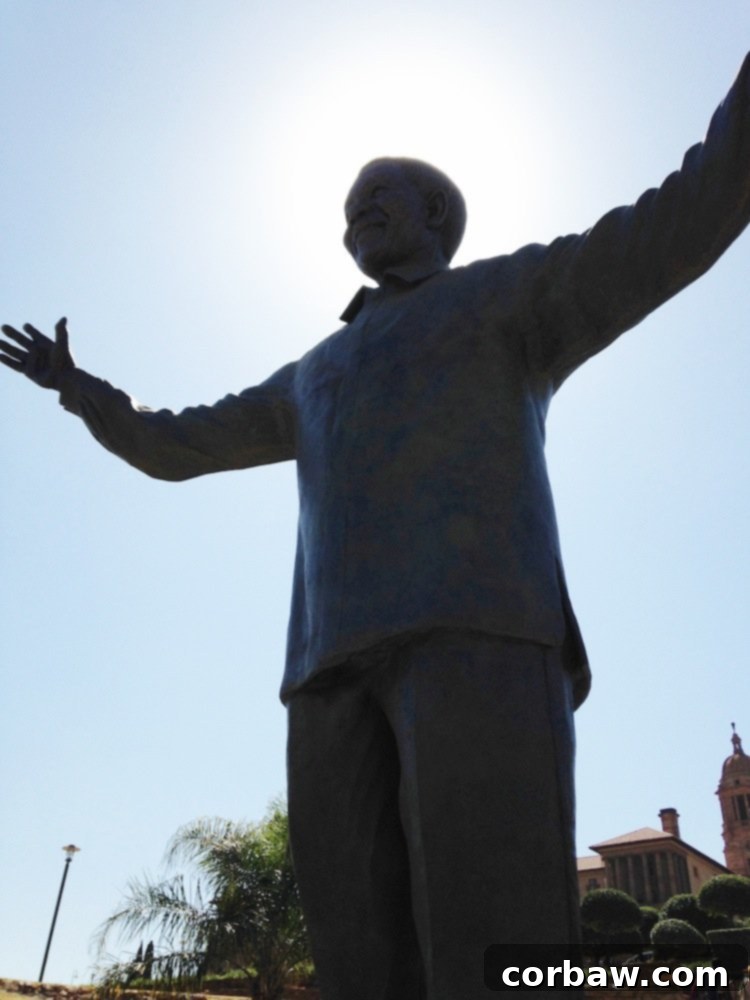Exploring Pretoria & Johannesburg: Unveiling South Africa’s Rich History and Culture

Our South African adventure, based out of the vibrant city of Cape Town, presented an exciting opportunity for one more unforgettable journey across the continent. After much deliberation and a delightful debate about potential destinations, my fiancé and I set our sights on the magnificent Victoria Falls. This choice was twofold: not only would it allow us to witness one of the world’s most breathtaking natural wonders, but it also promised the unique experience of exploring two additional African nations, Zimbabwe and Zambia. The prospect of expanding our African footprint and immersing ourselves in such diverse landscapes fueled our excitement for this leg of our trip.
Strategic Stopover: Navigating Johannesburg and Pretoria
As our journey to Victoria Falls necessitated a flight layover in Johannesburg, we seized the opportunity to transform this transit into an enriching 24-hour exploration. Instead of merely passing through, we decided to spend a night in the Gauteng province, allowing us to delve into some of the region’s prominent sights. A crucial aspect of our planning involved transportation. My fiancé, with commendable foresight, researched taxi costs from O.R. Tambo International Airport. Given the significant distance from the airport to both Johannesburg and our intended destination of Pretoria, the figures quickly pointed towards one clear solution: renting a car.
This decision proved to be an absolute game-changer, saving us a substantial amount of money. Beyond the cost efficiency, a rental car offered unparalleled freedom and flexibility, especially vital for tourists navigating South Africa. While public transportation exists, it is not as widely utilized or comprehensively structured for independent tourist travel in many areas, and can pose challenges regarding routes and perceived safety. For anyone visiting any city in South Africa, I wholeheartedly recommend considering a rental car and bringing your own GPS device or utilizing reliable offline map applications on your smartphone. We found Europcar to be incredibly reliable and efficient during our brief but action-packed visit, making our short stay much smoother and more enjoyable. Another fantastic advantage of having our own vehicle straight from the airport was the ability to securely store our luggage, a true blessing when embarking on a whirlwind 24-hour excursion like ours without immediate hotel check-in.
The Grandeur of the Union Buildings, Pretoria
Our first destination directly from the airport was the iconic Union Buildings in Pretoria. These magnificent structures, perched majestically on top of Meintjieskop hill, serve as the official seat of the South African government and house the offices of the President and his staff. Pretoria holds the distinction of being the executive capital among South Africa’s three capital cities, alongside Cape Town (legislative) and Bloemfontein (judicial). Constructed from light sandstone in a grand neoclassical style, the Union Buildings were completed in 1913, designed by the renowned architect Sir Herbert Baker. Their impressive scale and architectural beauty stand as a testament to a pivotal moment in South African history – the unification of the country into the Union of South Africa.
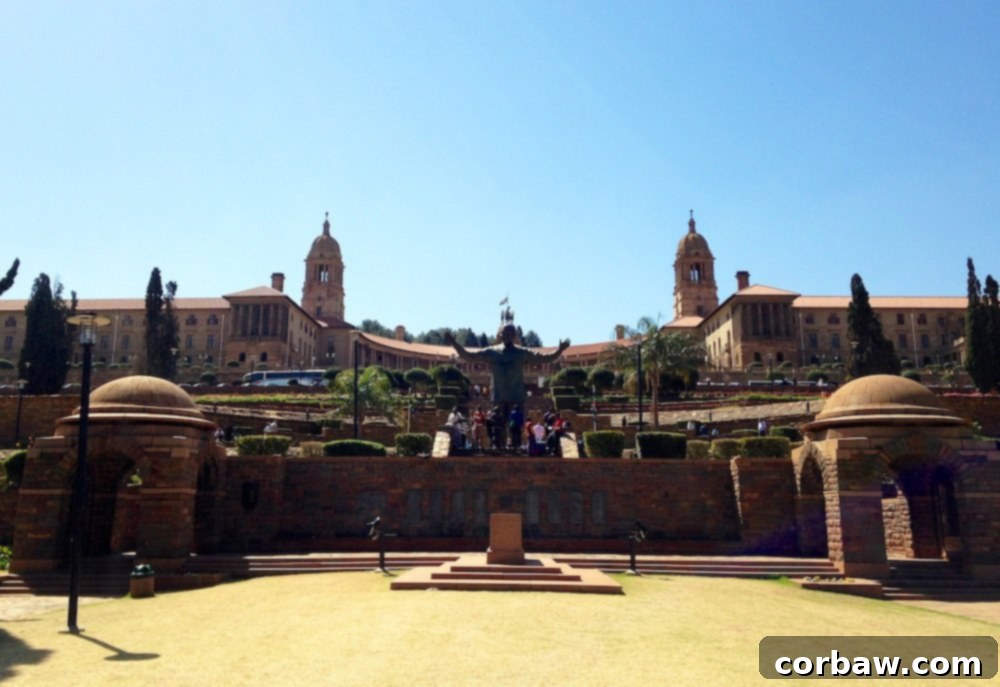
From their elevated position, the Union Buildings offer an absolutely breathtaking panoramic view of Pretoria, often referred to as the “Jacaranda City” due to its stunning purple-blossomed trees that adorn the streets in springtime. The meticulously manicured terraced gardens surrounding the buildings invite visitors to stroll and admire the expansive city below. In 2013, a truly monumental addition graced the grounds: a towering nine-meter bronze statue of Nelson Mandela. Unveiled on December 16, 2013, exactly 100 years after the Union Buildings themselves were completed, this statue quickly became an emblematic symbol of post-apartheid South Africa and its inspiring journey towards reconciliation. While we’ve encountered numerous statues of Madiba since moving to South Africa, this particular rendition, with its immense scale, outstretched arms, and powerful presence, truly stands out as one of my personal favorites, capturing his spirit and enduring legacy in a profound way.
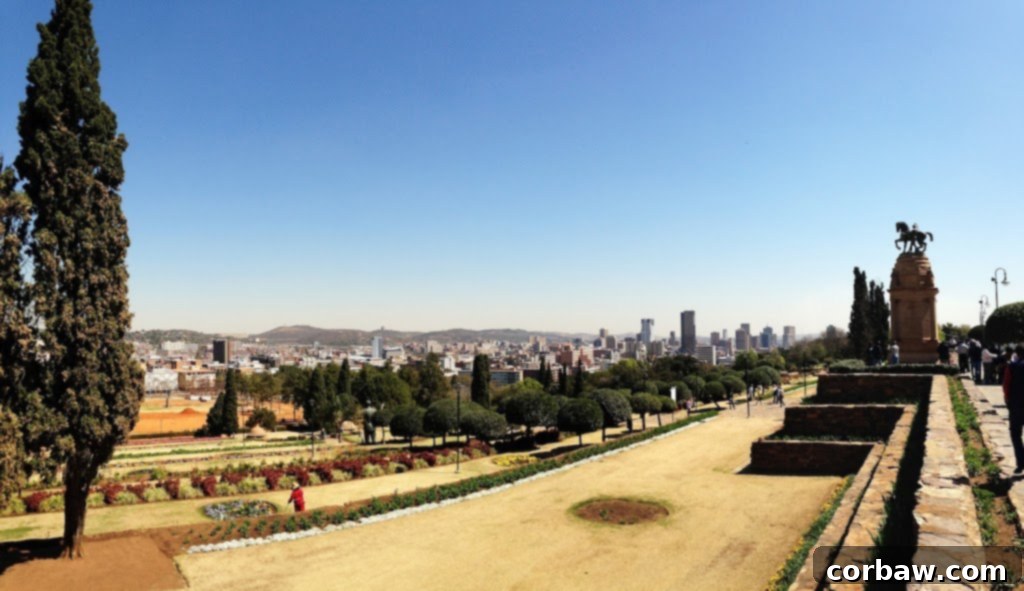
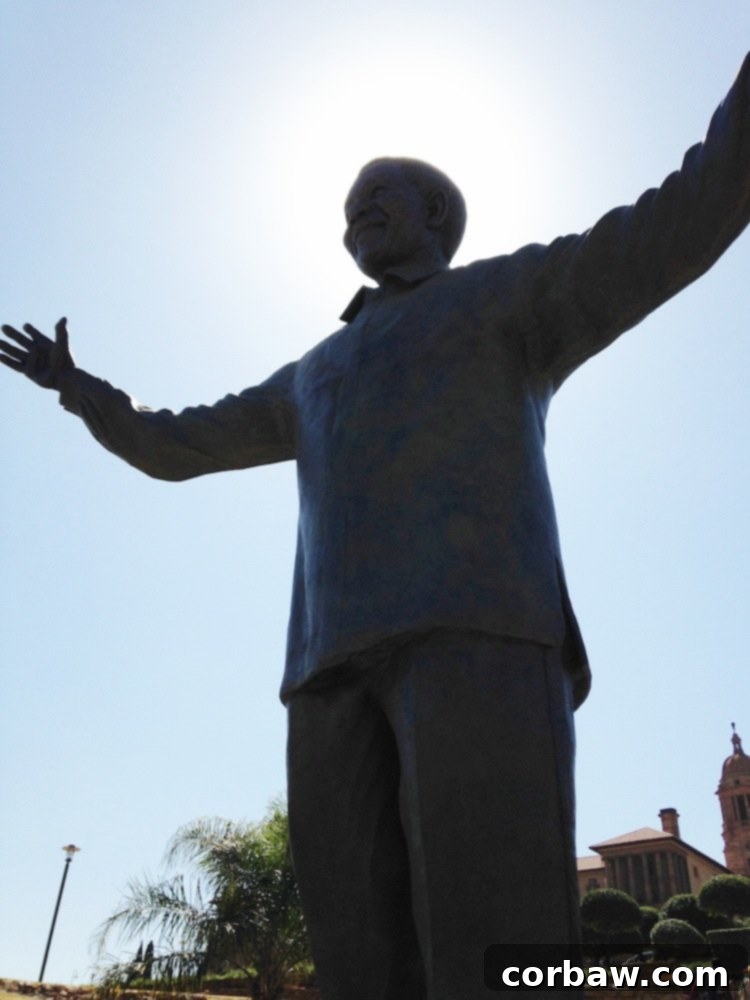
To truly appreciate the sheer scale of this impressive artwork, here I am, standing proudly at the base of the statue, offering a vivid sense of its towering presence and the incredible artistry involved in its creation.
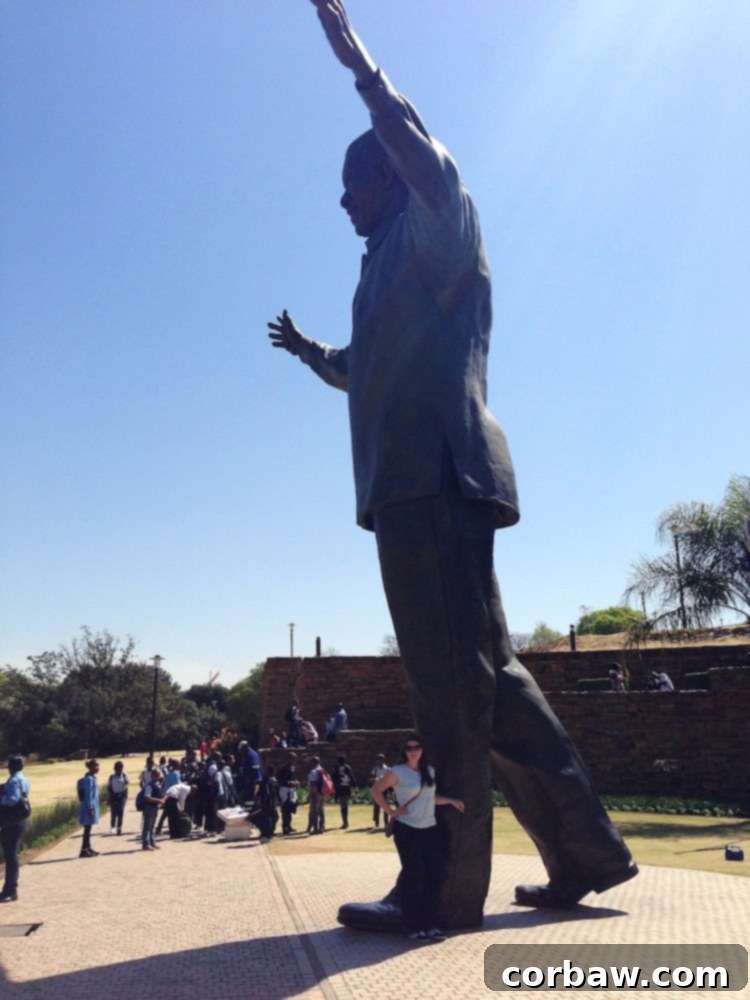
The Union Buildings are undeniably beautiful and exude an aura of national significance. The experience of walking through the gardens and witnessing this seat of power was deeply moving. I’m incredibly grateful that we decided to make this stop an integral part of our brief visit to Gauteng. My fiancé took the reins in planning our activities in the Johannesburg area, and I must commend him on an excellent choice, perfectly blending history with architectural magnificence!
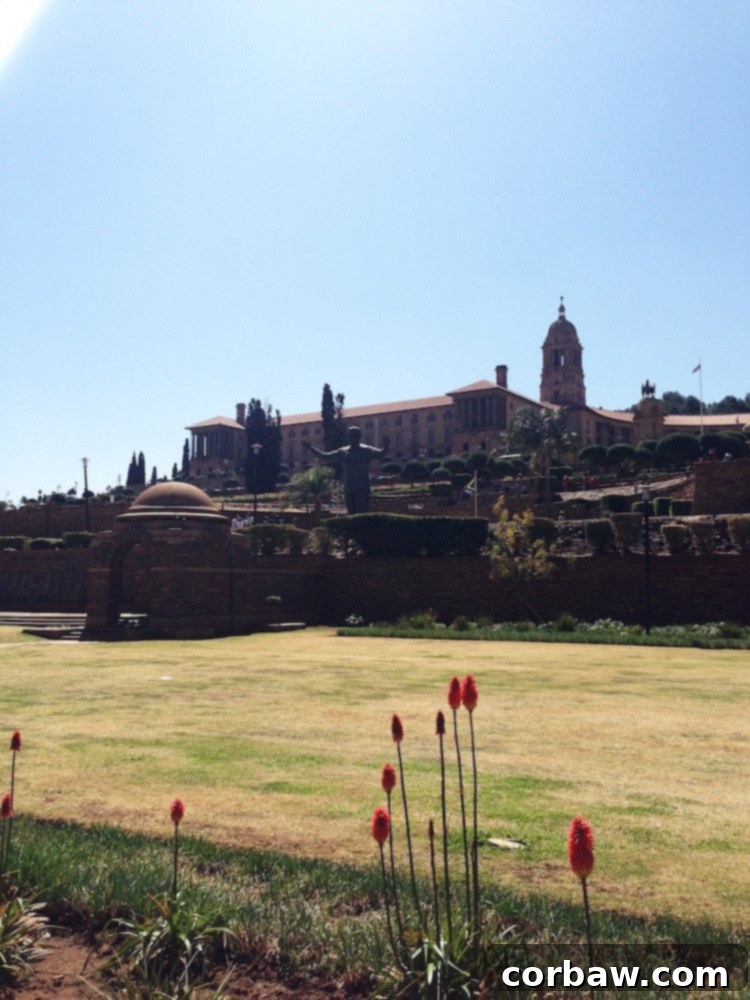
The Voortrekker Monument: A Glimpse into Afrikaner History
Our next significant stop led us to the Voortrekker Monument, a striking edifice clearly visible from the Union Buildings, creating an interesting visual dialogue between these two historical landmarks. In fact, a local regulation stipulates that no building constructed between these two iconic sites can be tall enough to obstruct the view between them, a testament to their enduring importance in the city’s landscape and historical narrative.
The Voortrekker Monument is without doubt one of South Africa’s most compelling, yet simultaneously controversial, landmarks. It stands as a colossal granite structure, dedicated to the Voortrekkers – Afrikaans-speaking pioneers of Dutch, German, and French Huguenot descent. These settlers embarked on what became known as the Great Trek in the mid-1800s, leaving the British-controlled Cape Colony (which includes the Western Cape, where my fiancé and I reside) to establish independent republics in the northern and eastern interior of what is now South Africa. Their motivations were complex, driven by a desire for independence from British rule, access to more land, and the preservation of their cultural and religious identity. In a nation celebrated for its vibrant multiculturalism, this monument powerfully encapsulates a very specific, and often debated, chapter of its complex history. The controversies surrounding the monument largely stem from its historical associations with Afrikaner nationalism and its perceived role in the narrative that preceded apartheid, making it a site of both historical reverence and ongoing national dialogue about identity and reconciliation.
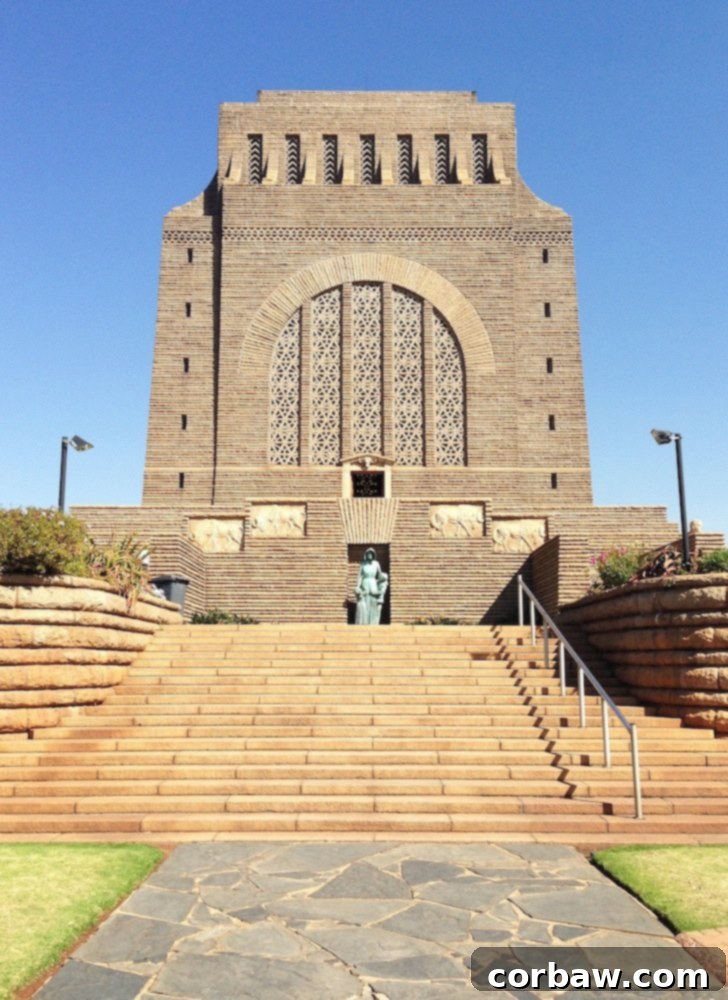
At the entrance, visitors are greeted by a poignant bronze sculpture by Anton van Wouw, depicting a Voortrekker woman and two children. This statue movingly commemorates the immense efforts and sacrifices made by women during the arduous Great Trek, highlighting their resilience and integral role in the pioneer movement, often facing extreme hardships alongside their male counterparts.
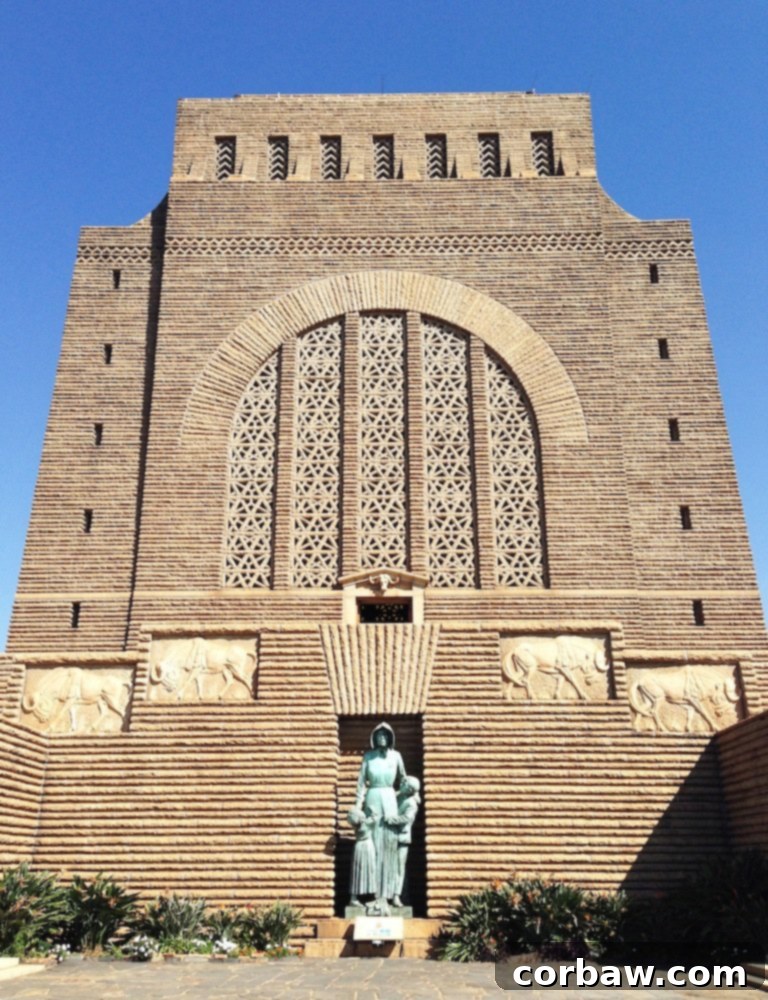
Upon entering the monument, one steps into the awe-inspiring Hall of Heroes, a vast domed chamber adorned with an elaborate marble frieze. This masterful series of relief sculptures, stretching along the entire length of the walls (measuring 92 meters), narrates the comprehensive story of the Great Trek. Beginning on the left, the frieze unfolds chronologically, depicting significant events, from daily life on the trek and crucial decisions made, to fierce battles fought against indigenous groups, culminating in the establishment of new settlements. The artistic detail and narrative power of these sculptures vividly bring this historical period to life, providing a deeply immersive experience into the Voortrekker perspective, showcasing their triumphs and tribulations through intricate artistry.

The intricate sculptures meticulously portray both the heroic struggles and the everyday realities of the pioneers, offering a detailed visual record of their journey and the challenges they faced in carving out a new existence in the South African interior.
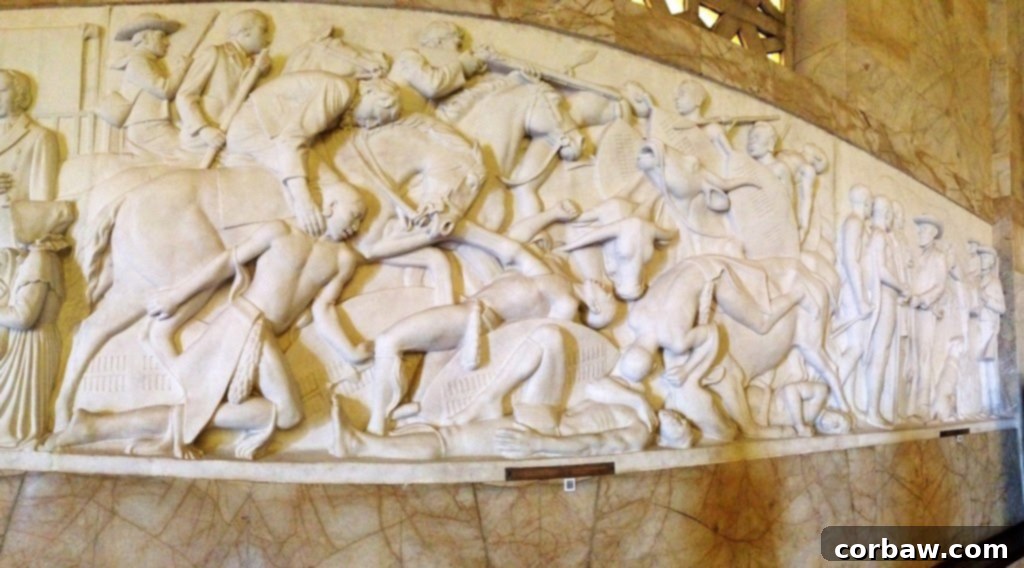
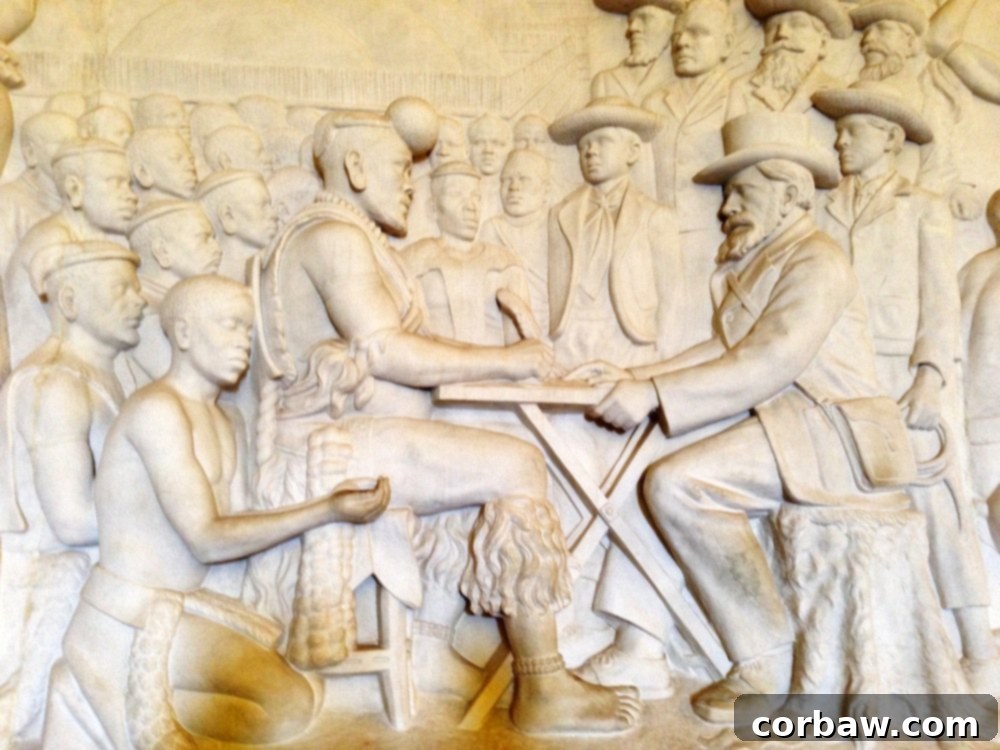
Directly beneath the Hall of Heroes, in the monument’s lower level, lies a solemn cenotaph – an empty tomb, serving as a symbolic resting place for those who perished during the Great Trek. This cenotaph is the focal point of a remarkable architectural phenomenon: precisely at noon on December 16th each year, a single ray of sunlight penetrates a specially designed opening in the dome above, illuminating the inscription on the cenotaph. This date marks the anniversary of the Battle of Blood River, a decisive conflict in 1838 where the Voortrekkers (Afrikaaners) achieved a significant victory over the Zulu forces. Prior to 1994, this day was commemorated as the “Day of the Vow,” a national holiday for many Afrikaners, signifying their covenant with God. However, with the end of apartheid in 1994, it was thoughtfully renamed the “Day of Reconciliation,” transforming it into a day dedicated to fostering national unity, healing the divisions of the past, and embracing a more inclusive South African identity.

The original “Day of the Vow” stemmed from a solemn promise made by the Voortrekkers to God on the eve of the Battle of Blood River. They pledged that if granted victory, they would build a church in His honor and forever observe the day as a Sabbath. The text of this historic vow is prominently displayed outside the monument, allowing visitors to connect directly with this foundational aspect of Voortrekker identity and belief, offering crucial context to the monument’s enduring significance.

The cenotaph room is further enriched by a display of flags representing the various Voortrekker Republics, alongside a stunning collection of tapestries. These intricate tapestries visually echo the narratives found in the frieze above, detailing scenes from the Great Trek with remarkable artistry. For an American visitor like myself, these depictions evoked a strong sense of familiarity, reminiscent of the portrayals of westward migration and the Oregon Trail in the United States, highlighting universal themes of pioneering spirit, the challenges of settlement, and the human desire for new frontiers.
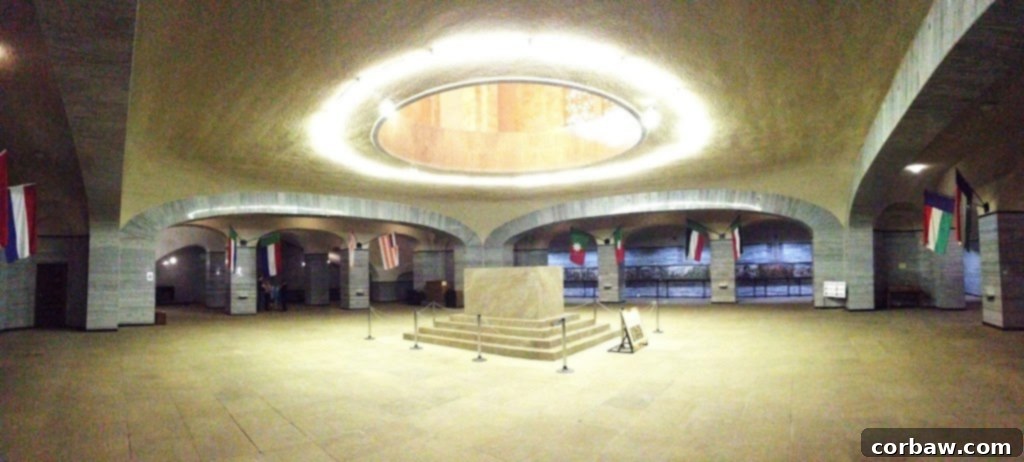

On the lowest floor, a comprehensive museum houses various artifacts from the Great Trek, offering tangible connections to the pioneers’ daily lives, tools, and struggles. After thoroughly exploring the historical depths of the monument’s interior, we embarked on a journey to its very summit. My fiancé, ever the advocate for fitness, insisted we take the stairs rather than the elevator. And while my legs might have felt a bit like jelly by the top, the reward was undeniable: an utterly spectacular panoramic vista of Pretoria and the surrounding Highveld landscape. Standing on the roof of the monument, we gained a unique perspective, soaking in the vastness of the city spread out beneath us, a truly memorable culmination to our visit.

Adding a delightful touch of authentic African wilderness to our historical exploration, we even spotted a few zebras and wildebeest grazing peacefully in the expansive fields surrounding the monument. It was a charming and unexpected reminder of South Africa’s rich biodiversity, beautifully juxtaposed with its profound human history. While the wildebeest may indeed be one of Africa’s less aesthetically pleasing animals with their somewhat ungainly appearance, their presence was certainly memorable and added a unique flavor to our day!
Evening in Sandton: Modern Johannesburg Charm
From the historical insights of Pretoria, we then made our way to our hotel located in Sandton, an affluent and bustling suburb often dubbed “Africa’s richest square mile” within Johannesburg. This modern district is known for its skyscrapers, luxury shopping, and vibrant urban energy. After a smooth check-in process – and a comical half-hour struggle by my fiancé to navigate the intricacies of the hotel’s multi-story parking garage (he still maintains it wasn’t his fault, citing confusing signage, but we’ll let him have that!) – our evening culminated at the vibrant Mandela Square.
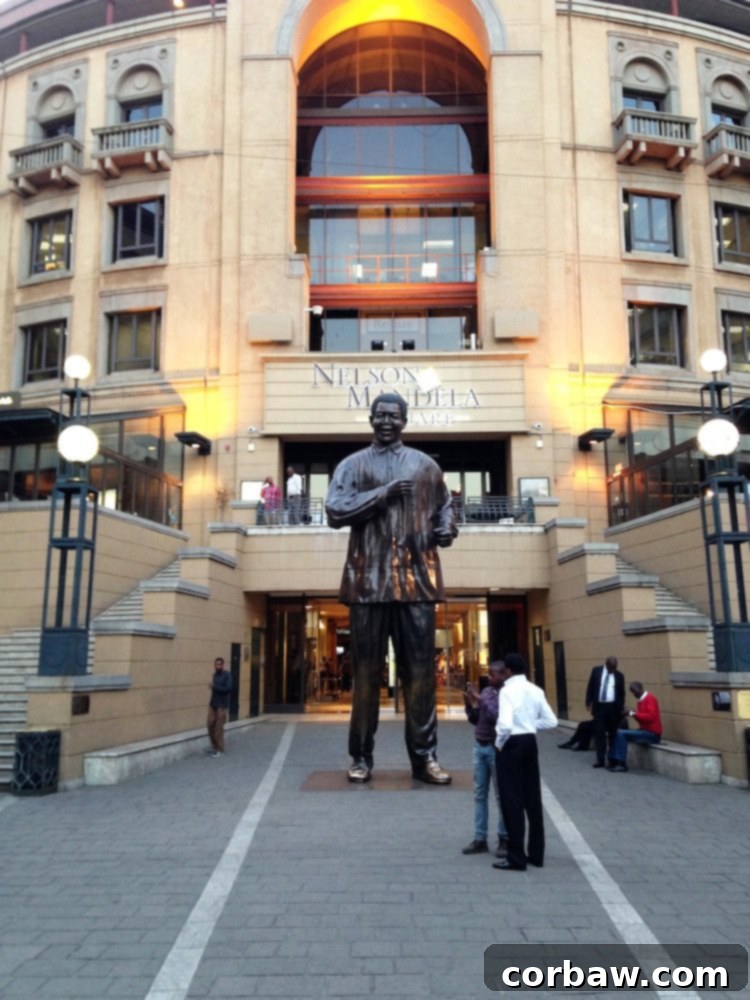
Mandela Square, with its towering bronze statue of Nelson Mandela offering a welcoming gesture and its lively atmosphere, is a prime destination for dining and entertainment. We spent some time exploring the upscale shops, browsing a variety of boutiques, and soaking in the energetic ambiance of the square. After grabbing a couple of refreshing drinks at a globally recognized restaurant chain (whose name I shall discreetly omit due to a mild sense of shame, but let’s just say it offered familiar comfort and a good spot for people-watching), we settled down for dinner at The Butcher Shop and Grill. This renowned steakhouse, a Johannesburg institution, did not disappoint with its excellent wine selection and overall good food. Although, I must confess, despite ordering my steak cooked to a specific temperature, I consistently find them arriving slightly undercooked in South Africa. Sorry, Dad, but it looks like I’ll have to start asking for a solid ‘medium’ from now on to hit that perfect sweet spot and enjoy a perfectly cooked piece of meat!
A Memorable Gauteng Experience
Overall, our quick yet incredibly enriching trip through Gauteng, encompassing both Pretoria and Johannesburg, was a resounding success. In just 24 hours, we managed to absorb a fantastic array of cultural and historical sights, gaining a deeper appreciation for South Africa’s multifaceted past and vibrant present. From the governmental gravitas of the Union Buildings and the complex narratives of the Voortrekker Monument to the modern vibrancy of Sandton and Mandela Square, our carefully curated itinerary allowed us to experience some truly iconic landmarks. While there’s undoubtedly a wealth more to explore in this dynamic province, our brief stopover proved invaluable and immensely rewarding. Stay tuned, because next week, I’ll be sharing all the breathtaking details and stunning photographs from our magnificent journey to Victoria Falls!
